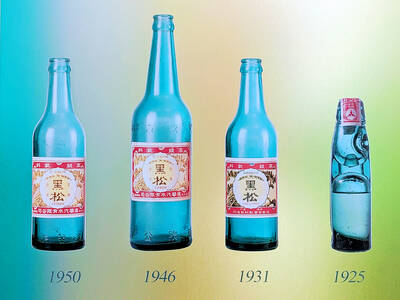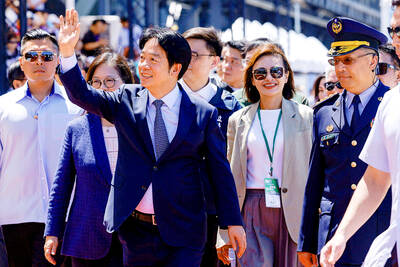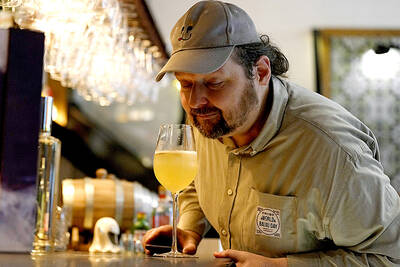VIEW THIS PAGE Rockin' on stage can get bloody for American band Story of the Year, which is known for its raucous, high-energy shows.
“I’ve been hit in the head a few times [by guitars] and blood will just be running down your face,” said lead vocalist Dan Marsala in an interview with the Taipei Times from his hotel in Nagoya, Japan, where the band just finished a run of shows.
But gore won’t be the centerpiece of Story of the Year’s concert tonight at The Wall (這牆) in Taipei. “We’ve been doing it for so many years that we’re really good at dodging each other now,” said the 28-year-old.
The band, originally from St Louis, plays modern hard rock, melding guitar-driven genres that thrived in the 1980s underground: thrash, hardcore metal, grunge and emo.
While not a household name, Story of the Year has enjoyed modest success and a large enough fan base to keep the group on a steady schedule of touring and recording. The band broke into the US rock scene with its debut album Page Avenue (2003), which went gold, and toured with groups like My Chemical Romance and Linkin Park.
Since the release of Story of the Year’s last album early last year, The Black Swan, the band has toured non-stop touching down in the US, Europe, Brazil and Japan.
“It’s what you’ve got to do to be in a rock band these days,” said Marsala. “It’s how people make money, now that nobody buys CDs anymore.”
Nonetheless Story of the Year is focused on making music with a message. Songs like Welcome to Our New War clearly show the members’ rage against the machine: The power elites wear the thickest disguise/Setting the rules as the classes divide they keep their heartless/Eyes on the prize and leave the masses with a lifetime of poverty and crime.
“I grew up listening to a lot of punk bands,” said Marsala. “That’s definitely where the inspiration for our politically driven music came from. Some of my favorite bands were Bad Religion and Propagandhi — a lot of political punk bands that I grew up listening to ... I’ve always been into music that had some kind of message, rather than love songs.”
Despite the “serious” content, the band still enjoys being a little “goofy” on stage. “You want to suit the music but you want to have fun at the same time,” he said.
Marsala says he particularly likes playing clubs like The Wall, which holds a maximum of around 500 people.
“If you’re playing a huge arena, you’re not going to feel the energy of the crowd,” he said. “There’s just something magical about a small room full of people, just screaming and having fun.”
Story of the Year’s show tonight begins a big weekend for The Wall. Tomorrow the venue hosts The Band Apart, a Japanese indie-pop group with a loyal following that regularly fills 1,000-seat venues, according to The Wall’s Miyuki Yang (楊懿琳), who is in charge of booking international acts.
The Tokyo-based band plays groove-oriented music full of jazzy guitar riffs, pop hooks and sweet vocal choruses. All the lyrics are sung in English by singer and guitarist Arai Takeshi.
Taiwanese audiences and indie musicians will relate to The Band Apart’s origins — its members started out as a heavy metal cover band but moved on to writing their own songs. The Japanese indie-music blog keikaku.net notes their “eclectic” influences such as bossa nova and emo, which can be heard in their song Shine on Me, which also has a strong J-pop feel. VIEW THIS PAGE

The unexpected collapse of the recall campaigns is being viewed through many lenses, most of them skewed and self-absorbed. The international media unsurprisingly focuses on what they perceive as the message that Taiwanese voters were sending in the failure of the mass recall, especially to China, the US and to friendly Western nations. This made some sense prior to early last month. One of the main arguments used by recall campaigners for recalling Chinese Nationalist Party (KMT) lawmakers was that they were too pro-China, and by extension not to be trusted with defending the nation. Also by extension, that argument could be

Aug. 4 to Aug. 10 When Coca-Cola finally pushed its way into Taiwan’s market in 1968, it allegedly vowed to wipe out its major domestic rival Hey Song within five years. But Hey Song, which began as a manual operation in a family cow shed in 1925, had proven its resilience, surviving numerous setbacks — including the loss of autonomy and nearly all its assets due to the Japanese colonial government’s wartime economic policy. By the 1960s, Hey Song had risen to the top of Taiwan’s beverage industry. This success was driven not only by president Chang Wen-chi’s

Last week, on the heels of the recall election that turned out so badly for Taiwan, came the news that US President Donald Trump had blocked the transit of President William Lai (賴清德) through the US on his way to Latin America. A few days later the international media reported that in June a scheduled visit by Minister of National Defense Wellington Koo (顧立雄) for high level meetings was canceled by the US after China’s President Xi Jinping (習近平) asked Trump to curb US engagement with Taiwan during a June phone call. The cancellation of Lai’s transit was a gaudy

The centuries-old fiery Chinese spirit baijiu (白酒), long associated with business dinners, is being reshaped to appeal to younger generations as its makers adapt to changing times. Mostly distilled from sorghum, the clear but pungent liquor contains as much as 60 percent alcohol. It’s the usual choice for toasts of gan bei (乾杯), the Chinese expression for bottoms up, and raucous drinking games. “If you like to drink spirits and you’ve never had baijiu, it’s kind of like eating noodles but you’ve never had spaghetti,” said Jim Boyce, a Canadian writer and wine expert who founded World Baijiu Day a decade